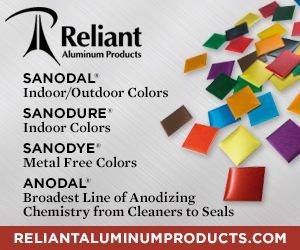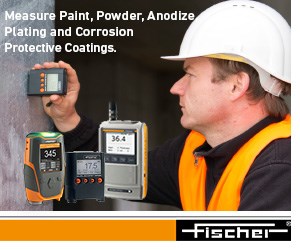CLEANING & PRETREATMENT
Narrow by Cleaning & Pretreatment Product Category
- Abrasive Blasting Equipment, Dry
- Abrasive Blasting Equipment, Glass Bead
- Abrasive Blasting Equipment, Wet, Vapor
- Abrasive Blasting Materials, Soda Blasting Media
- Abrasive Grain
- Acid Salts
- Air Blow-Off Devices, Air Knives
- Aluminum Etchants & Deoxidizers
- Analytical Equipment, Automatic Solution Titration
- Anti-Static Solutions, Static Eliminators
- Associations, Tradeshows & Professional Groups
- Balls, Floating Plastic (for Solution Heat Retention and/or Fume Suppression)
- Baskets, Dipping, Pickling, Handling
- Blowers, Air (for Push-Pull Ventilation)
- Chemical Process Equipment
- Chemical Transporting Equipment
- Chromate Conversion Coatings
- Chrome-Free Final Rinses (for Paint Pretreatment)
- Chromium-Free Conversion Coatings for Aluminum
- Cleaning & Phosphating Chemical Feeders
- Cleaning & Phosphating Equipment
- Cleaning & Pretreatment Chemicals
- Cleaning Chemicals, Aqueous
- Cleaning Chemicals, Solvent
- Cleaning Equipment, High-Pressure Wand
- Cleaning Equipment, Ultrasonic
- Cleaning Systems, Aqueous or CFC-free
- Cleaning Systems, Centrifugal
- Coatings, Dry-film or Solid-film Lubricant
- Coils, Liquid Heating & Cooling
- Compressors, Air
- Consultants, Independent, Paint Pretreatment
- Consultants, Independent, Parts Cleaning
- Controls, Alkalinity Regulation
- Controls, Effluent Monitoring
- Controls, Fluid Pressure
- Controls, Liquid Level
- Controls, pH
- Controls, Rinse Tank Concentration
- Controls, Solution Conductivity
- Controls, Temperature
- Deburring Services
- Degreasers, Solvent, Vapor
- Deionizers, Demineralizers
- Descaling Chemicals
- Descaling Equipment, Molten Salt
- Distillation Equipment
- Dryers, Centrifugal
- Dryers, Rotary, Spiral
- Dryers, Solvent
- Dryers, Vibratory
- Dyes for Chromate and/or Phosphate Coatings
- Equipment Engineering & Installation Services
- Flow Meters, Liquid
- Heat Exchangers
- Heaters, Immersion
- Inhibitors, Acid Pickling
- Nozzles, Liquid Spray
- Oil Recovery & Recycling
- Oil Skimmers, Separators
- Paint & Rust Stripping Services
- Paint Strippers, Chemical
- Paint Stripping Equipment & Materials, Plastic Abrasive Media Blast
- Paint Stripping Equipment, Burn Off
- Paint Stripping Equipment, High-Pressure Water Spray
- Paint Stripping Equipment, Hot Fluidized Bed
- Paint Stripping Equipment, Molten Salt Bath
- Paint Stripping Materials for Molten Salt Baths
- Paint Stripping Materials, Sodium Bicarbonate
- Paint Stripping Materials, Solvent-Based
- Paint Stripping Materials, Starch Blast Media
- Paint Wipers
- Parts Washers, Mechanically Agitated
- pH Electrodes
- pH Meters
- pH Papers
- Phosphate Coating Chemicals
- Pickling Solutions
- Plasma Surface Treatment Systems
- Rack Stripping Equipment
- Rinse Aids
- Rust Removers
- Rust-Converting Coatings
- Rust-Preventive Chemicals & Oils
- Smut Removers, Aluminum
- Sodium Hypophosphite
- Solvent Stills & Recovery Equipment
- Solvents, Degreasing
- Solvents, Mask Washing
- Steam Cleaning & Phosphating Apparatus
- Steam Cleaning Compounds
- Stripping Solutions, Metal
- Stripping Tools, Paint
- Surface-Active Agents
- Tack Cloth, Dust Removal Cloths & Mitts
- Tarnish-Preventive Treatments
- Test Kits, Water Analysis
- Testing Equipment, Solution Concentration
- Testing Equipment, Surface Cleanliness
- Testing Equipment, Surface Tension
- Transducers, Ultrasonic
- Used Equipment
- Washers, Small Parts
- Washing Machines, Spray Mask
- Water-Softening Equipment
FAQ: Cleaning & Pretreatment
How do I clean brass to be powder coated?
Assuming you have some mill oil or metalworking lubricant on the surface of the brass, the minimum pretreatment needed is a degreasing of some type. Depending on what you have available and the number and size of your parts, that could range from a manual wiping with a solvent from your hardware store (naphtha or mineral spirits) with clean, lint-free rags, to a fully automated, conveyorized spray wash system. You will need to make the decision as to what to do based on the size of the operation you are undertaking.
If only applying a clear powder coat, then you will need to brighten the brass in some way. This can be accomplished by use of specially formulated cleaners. Most are mildly to strongly acidic. This deoxidizes and brightens the surface prior to powder coating. (Source: Parts Cleaning Clinic: Brass Cleaning)
What factors effect pretreatment costs?
Energy usage. This can be significant depending on how many stages are heated and to what temperature. This would largely be a fixed cost regardless of how many square feet you are processing. You may be able to turn off recirculation pumps and lower tanks’ temperatures, but you will generally not be shutting down the entire system unless it is for a longer plant shutdown. Additionally, you should have a dry-off oven, which will be a significant source of energy usage.
Chemical usage. This will largely be dependent on the area of material processed. I have seen pretreatment chemical costs vary significant (a factor of two for functionally the same chemicals). The usage cost is usually a function of actual concentration required in the process and the dump frequency needed.
Capital costs. Installing a five-stage pretreatment system along with the associated support equipment (oven, conveyor and waste treatment or holding) will cost a sizable amount—typically several hundred thousand dollars on the low end and more than a million dollars on the high end. This cost of capital needs to be captured in your cost model and would typically involve the depreciation value along with a markup to cover the cost of the investment.
Labor. Loading/unloading the conveyor, system maintenance and troubleshooting, quality checks of each stage, oven profiles, final part inspection, packaging, shipping and receiving will all need to be done by trained personnel. Payroll and benefits to these employees will need to be factored into your cost model. (Source: Estimating Pretreatment Costs)
What are effective pretreatments to chrome and for painting over the chrome?
Generally, you need to effectively clean your parts prior to any chrome plating. This may involve the use of an alkaline electrocleaner with a periodic reversed current. This would be followed by thorough rinsing and possibly the use of a dilute acid cleaner with rinsing to neutralize any residual alkaline cleaner. Some shops will first do a copper plating, while others will go directly to the nickel plating. Regardless, either process will require a nickel plating to provide a good base for the chromium as well as good corrosion resistance. (Source: Chrome Pretreatment)
How can I shorten the pretreatment time for my batch powder painting operation?
First, examine the incoming parts or sheet material. Are they coming in the door rusted? If so, can you work with your suppliers to change this or have them perform the de-rusting before you receive the parts? If the rust is occurring within your manufacturing process, you can work to eliminate it through the use of in-house light oils or indoor corrosion inhibitors and reducing the amount of in-process time the parts are allowed to sit between processing steps. (Source: Pretreatment Duration)
What are the best types of cleaning for preparing a part for coating?
Mechanical cleaning (abrasion) is a common way to prepare a part for coating. It has a great advantage over chemical cleaning because it promotes exceptional physical adhesion. The coating flows over a much larger surface area and into all the roughened areas created by the abrasion which holds it on tightly, providing the necessary adhesion—the first challenge to getting good performance. Chemical cleaning has a distinct advantage also. It does a much better job of removing organic (think oil) soils. It can also be used to apply a conversion coating, promoting adhesion and adding corrosion protection. (Source: Best Possible Pretreatment)
What are the pros and cons of room-temperature-pretreatment?
The obvious pro to the room temperature pretreatment is the energy savings related to decreased use of utilities to heat process tanks.
The current system you mention used to clean oils and rust inhibitors would not be very effective if it did not contain surfactants for removal of the soils. A fully formulated alkaline cleaner may be more effective, but if you are getting adequate results with the current process, it leads me to believe that you either have oils that are very light and easily removed or that your cleanliness requirements are not very great. Given that, a room temperature cleaning process may be worth looking into. Generally speaking, cleaning is more effective if done at elevated temperatures, however there are some products formulated to clean fairly well at lower temperatures. I would suggest not relying on only the one you have found in your research, but also investigate a couple competitors to evaluate not only how effective the chemistry is, but judge the total package, including tank life, waste products and service. (Source: Pros and Cons for Ambient Temp Pretreatment)
Get Listed!
Thousands of people visit this Supplier Guide every day to source equipment and materials. Get in front of them with a free company profile.






